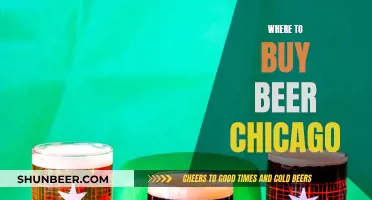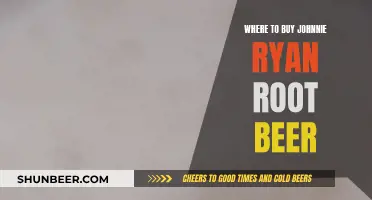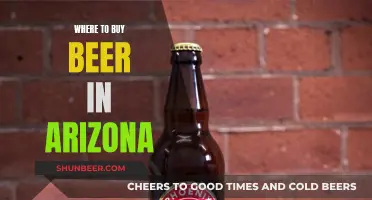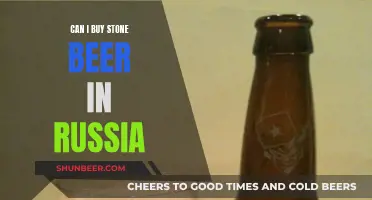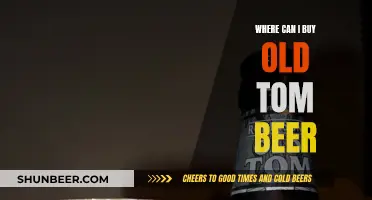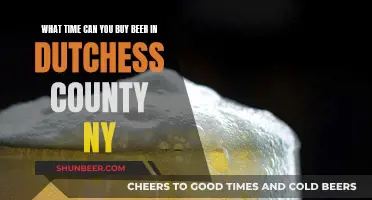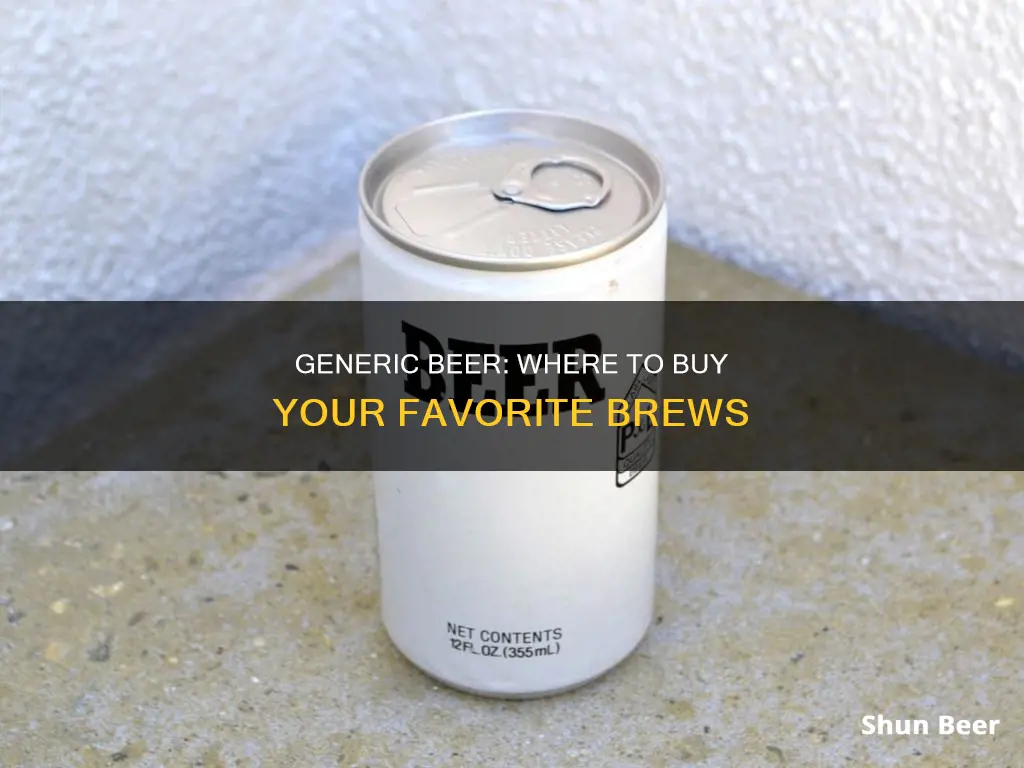
In the 1970s and 1980s, it was common to find generic beer in the United States, which was sold at low prices in plain packaging with minimal branding and marketing. One of the most well-known examples of this was a beer simply called BEER, which was brewed by Falstaff Brewing and sold in 12-ounce white cans with black lettering. While generic beer brands like this are no longer widely available, there are still some options for those seeking inexpensive beer, such as Big Flats at Walgreens and Moe's Tap Room from Kroger stores.
| Characteristics | Values |
|---|---|
| Packaging | Stark white can with black lettering |
| Price | $1.19 for a 6-pack ($0.20 per can) |
| Retailers | Piggly Wiggly, Valu King, 7/11, Walmart, Ralph's |
| Manufacturer | Falstaff Brewing |
| Distributor | Miller Brewing Company |
| Serving | 12-ounce cans |
What You'll Learn

Generic beer in the 1970s and 1980s
In the 1970s and 1980s, consumers could buy generic beer, which simply went by the name "BEER". It was a cheap, pale lager, sold in plain white cans with the word "BEER" in bold black font. It was brewed by Falstaff Brewing, under the umbrella of the General Brewing Company, from their Fort Wayne brewery. The beer was intentionally unadvertised and cheaply packaged to save on costs, allowing it to be sold at a low price. It could be found in stores like 7/11 and Walmart for mere pennies.
The rise of generic beer in the 1970s was a result of high interest rates and inflation. Consumers were offered similar products to well-known brands but at much cheaper prices. Ralph's, a company based in California, was one of the first major plain-label beer brands, and their generic products, including beer, quickly spread across America. Their "President's Choice" beer is the only classic generic beer from that era that is still sold today, but only in Canada.
Falstaff Brewing, which produced BEER, also brewed unlabelled beers for other companies, such as Ralph's generic brand, Scotch Buy, Always Save, and Cost Cutter. They also produced a slightly less generic brand called Steinbrau, which used the same low-cost model of minimalist branding and packaging.
As the 1980s came to a close, the popularity of generic products, including generic beer, began to wane. The novelty wore off for consumers, and plain-label generic items started to be seen as cheap and second-rate. The rise of the craft beer market also contributed to the decline of generic beer, as more private label beers entered the market and took shelf space from generic brands.
While BEER is no longer available, some modern-day equivalents can be found. Stores like Walgreens and Kroger have upgraded the packaging and branding of their own generic beers, such as Big Flats and Moe's Tap Room, which are still cheap but have more customer appeal. With the threat of a recession, it is possible that generic beers will make a comeback, offering consumers a more affordable alternative to the increasingly expensive craft beers.
Best Places to Buy Root Beer Floats
You may want to see also

Generic beer today
Today, while you may not find the classic "BEER" cans of yesteryear, there are still some options for those seeking affordable, no-frills beer. Stores like Walgreens have released their own branded beers, such as Big Flats 1901 Premium American Lager, which retails for around $2.99 for a six-pack or $11.49 for a 24-pack—a price that harkens back to the days of dirt-cheap generic beers. Similarly, Kroger stores offer Moe's Tap Room, which also provides a budget-friendly option for beer drinkers.
While these modern generic beers have upgraded their branding and packaging, they remain true to the original concept of offering inexpensive beer without the frills and marketing of their craft counterparts. With the increasing prices of craft beer, it's no surprise that some consumers are once again turning to these budget-friendly options.
However, it's worth noting that the taste and quality of these generic beers may not always live up to the standards of more expensive craft beers. Some have described the taste as "repugnant," reminding them of "cat piss." Nonetheless, for those seeking a cheap drink, these generic beers may still be a popular choice, especially during tough economic times.
So, while the classic generic beers of the past may no longer exist, today's consumers can still find budget-friendly beer options on the market. As the saying goes, you get what you pay for—and in the case of generic beer, that may not always be a bad thing.
Buying Beer Legally: Age Limit and Drinking Laws Explained
You may want to see also

Why the US fell out of love with generic beer
In the 1970s, the United States faced a recession, with high interest rates and inflation. This meant that Americans had less money to spend on consumer goods. Generic products, which offered similar products to well-known brands at much cheaper prices, became popular. Beer, being America's favourite drink, was an obvious choice to enter the market.
One of the first major plain-label beer brands was Ralph's out of California. Within a few years, their generic products, including beer, had swept across America. Other major breweries also jumped on the trend, including Falstaff Brewing, which was bought out by S&P in 1975. Falstaff's "Beer" and "Lite Beer" were brewed under the umbrella of the General Brewing Company and sold for mere pennies per can.
However, as the 1980s came to a close, the popularity of generic products began to wane. The novelty wore off for consumers, and plain-label generic items started to be viewed as cheap and second-rate. The rise of the craft beer market also contributed to the decline of generic beers, as more private label beers entered the market and took up shelf space.
By the 1990s, the generic beer trend had all but disappeared. Today, beer is often positioned as crafty, fancy, and expensive, with pricing that continues to increase. However, with a threatened recession on the horizon, it remains to be seen if generic beers will make a comeback.
Virginia Beer Distributors: Buying Back Beer from Stores?
You may want to see also

The future of generic beer
In the 1970s and 1980s, generic beer was a common sight. With plain packaging, often just a white can with the word "BEER" in bold black font, it was a no-frills, cheap option. These beers were often produced by major breweries, like Falstaff, and sold under generic brand names, such as Ralph's "President's Choice", which is still available in Canada today. The appeal of these beers was their low cost, made possible by minimal advertising and packaging expenses.
However, as the 1980s drew to a close, the popularity of generic products began to wane. Consumers started to associate plain-label items with low quality, and the rise of craft beer brought more options to the market, pushing generic beers out of the spotlight. The major breweries that had once produced these beers shifted their focus to more profitable branded options.
Today, the beer market is dominated by craft beers, which are often expensive and come in small servings. However, this could create an opportunity for the return of generic beer. Just as in the wine industry, where cheap options are available, some brewers may recognise the demand for inexpensive beer and bring back generic options. In fact, we're already seeing signs of this, with retailers like Walgreens offering their own branded beers, such as Big Flats 1901 Premium American Lager, at very low prices.
So, will generic beer make a full comeback? It's possible. With economic pressures and a desire for more affordable options, consumers may be willing to trade the fancy branding and marketing of craft beers for a simple, cheap beer. The success of retailers' branded beers and the potential for even lower prices could drive this trend. However, it's also important to note that the beer market has evolved, and today's consumers may have higher expectations for flavour and quality than in the past.
Steam Whistle Beer: Where to Buy and Enjoy
You may want to see also

The rise of craft beer
In the UK, London has seen a boom in microbreweries and bars serving craft beers, with similar trends emerging across the country. A study by pub chain Brewhouse and Kitchen found that 65% of beer-loving Londoners now prefer craft beers over mainstream beers, and that sales of craft beer have increased by 48% in the last year, outpacing all other beer categories.
The craft beer movement has also had a significant impact on drinking culture. The variety of styles and flavours offered by craft breweries has encouraged consumers to experiment and expand their palates, moving away from the limited options of traditional lager and ale. This has created a demand for more adventurous and innovative beers, with consumers seeking out new and interesting drinking experiences.
Despite the challenges posed by distribution laws and competition from large, established breweries, the craft beer sector continues to thrive and evolve. With consumers increasingly prioritising quality and variety in their drinking choices, the popularity of craft beer shows no signs of slowing down.
Rainier Beer in Texas: Where to Buy?
You may want to see also
Frequently asked questions
You can buy generic beer at your local 7/11 or Walmart.
Generic beer is a type of beer that is not branded and is typically sold in plain packaging, such as a white can with black lettering that simply says "BEER".
Generic beer is known for being very cheap, costing only pennies per can.
Generic beer offers a similar product to many of the better-known brands but at a much cheaper price, as it saves on the costs of elaborate packaging and expensive marketing.


